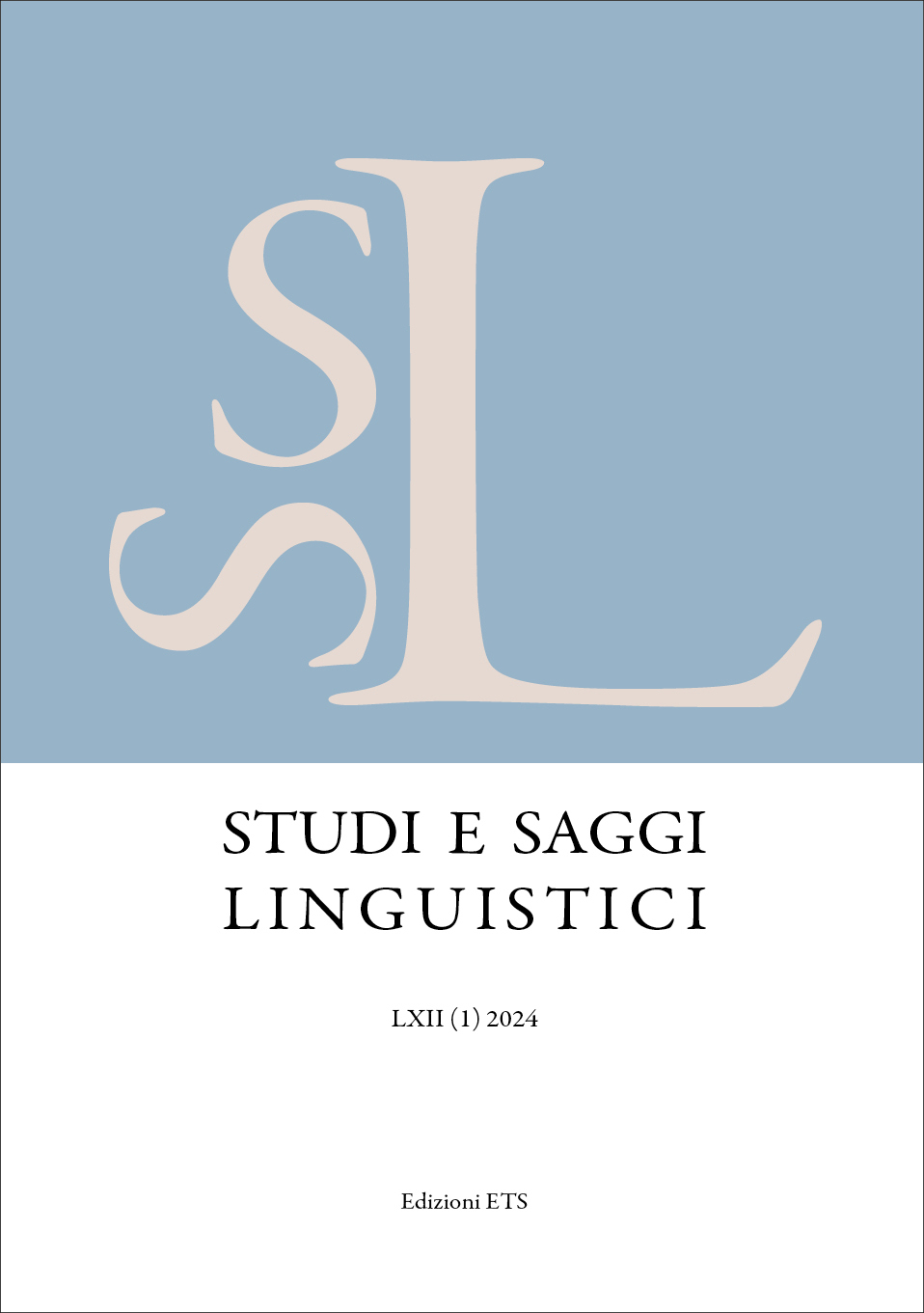Un’analisi morfosintattica e morfosemantica dei suffissoidi dello slang inglese
Pubblicato 2024-07-11
Parole chiave
- English slang,
- morphosyntactic patterns,
- schemas,
- suffixoids,
- Construction Morphology
Abstract
Questo studio indaga i suffissoidi (Sfsd) dello slang inglese, come -ass (in fat-ass), -brain (in birdbrain), -face (in shitface) e -head (in airhead), dal punto di vista morfosintattico e morfosemantico. La produttività di questi elementi morfologici e il loro carattere transizionale, che si colloca al confine tra composizione e derivazione, sono stati ampiamente dimostrati. In questo studio, l’attenzione è rivolta ai due modelli morfosintattici privilegiati che creano nomi denominali e deaggettivali, ovvero [[X]N [Sfsd]N]N e [[X]A [Sfxd]N]N, e alla loro interpretazione letterale o figurata. Un’analisi qualitativa di un dataset estratto dal Corpus of Contemporary American English (COCA) e dal Green’s Dictionary of Slang (2023) mostra la natura metonimica generale dei suffissoidi, che si riferiscono a individui, trasmettendo quindi il sema [umano] facendo riferimento a una parte del corpo con un intento negativo [peggiorativo]. L’analisi mira a individuare schemi regolari per esaminare e comprendere i sostantivi inglesi che presentano un suffissoide, nonché per la previsione di nuove parole con gli stessi elementi morfologici.
Riferimenti bibliografici
- AMIOT, D., and DUGAS, E. (2021), Combining forms and affixoids in morphology, in LIEBER, R. (2021, ed.), The Oxford Encyclopedia of Morphology, Oxford University Press, Oxford, https://www.oxfordreference.com/view/10.1093/acref/9780190682361.001.0001/acref-9780190682361-e-569.
- AUTHOR (2008).
- AUTHOR (2017).
- AUTHOR (2019).
- AUTHOR (2022).
- AUTHOR (2023).
- BAAYEN, H.R. (1993), On frequency, transparency and productivity, in BOOIJ, G. and VAN MARLE J. (1993, eds.), Yearbook of Morphology 1992, Kluwer Academic Publishers, Dordrecht, pp. 181-208.
- BAUER, L. (2001), Morphological Productivity, Cambridge University Press, Cambridge.
- BAUER, L. (2017), Compounds and Compounding, Cambridge University Press, Cambridge.
- BAUER, L. (2022), Interlocking paradigms in English compounds, in RUZ, A.E., FERNÁNDEZ-ALCAINA, C. and LARA-CLARES, C. (2022, eds.), Paradigms in Word Formation: Theory and Applications, John Benjamins, Amsterdam/Philadelphia, pp. 59-68.
- BOOIJ, G. (2009), Word-formation templates and the hierarchical lexicon, in LIEBER, R. and ŠTEKAUER, P. (2009, eds.), The Oxford Handbook of Compounding, Oxford University Press, Oxford, 201-216.
- BOOIJ, G. (2010), Construction Morphology, Oxford University Press, Oxford.
- BOOIJ, G.E., and HÜNING, M. (2014), Affixoids and constructional idioms, in BOOGAART, R., COLLEMAN, T. and RUTTEN, G. (2014, eds.), Extending the Scope of Construction-based Grammar, de Gruyter, Berlin/Boston, pp. 77-106.
- BOOIJ, G. (2015), The nominalization of Dutch particle verbs: Schema unification and second or-der schemas, in «Nederlandse Taalkunde», 20, pp. 285-314.
- BOOIJ, G. (2019), The role of schemas in Construction Morphology, in «Word Structure», 12, pp. 385-395.
- DAVIES, M. (2008–), Corpus of Contemporary American English (COCA), https://corpus.byu.edu/coca/.
- DOWNING, P. (1977), On the creation and use of English compound nouns, «Language», 53, pp. 810-842.
- GOLDBERG, A. (1995), Constructions. A Construction Grammar Approach to Argument Structure, Chicago University Press, Chicago.
- GOLDBERG, A. (2006), Constructions at Work. The Nature of Generalization in Language, Oxford University Press, Oxford.
- GREEN, J. (2023), Green’s Dictionary of Slang, https://greensdictofslang.com/.
- JACKENDOFF, R. (2002), Foundations of Language, Oxford University Press, Oxford.
- JESPERSEN, O. (1942), A Modern English Grammar on Historical Principles. Part VI: Morphology, Ejnar Munksgaard, Copenhagen.
- MATISOFF, J. (1991), Areal and universal dimensions of grammaticalization in Lahu, in TRAUGOTT, E.C. and HEINE, B. (1991, eds.), Approaches to Grammaticalization: Vol. II, John Benjamins, Amsterdam/Philadelphia, pp. 383-454.
- PAUL, H. (1880), Prinzipien der Sprachgeschichte, Max Niemeyer, Halle.
- PAUL, H. (1891), Principles of the History of Language, Translated by STRONG, H.A. from the second edition of the original, Longmans, Green and Co., London.
- SÁNCHEZ FAJARDO, J.A. (2022), Pejorative Suffixes and Combining Forms in English, John Benjamins, Amsterdam/Philadelphia.
- SÁNCHEZ FAJARDO, J.A. and AUTHOR (forth.).
- STEVENS, C.M. (2005), Revisiting the affixoid debate. On the grammaticalization of the word, in LEUSCHNER, T., MORTELMANS, T. and DE GROODT, S. (2005, eds.), Grammatikalisierung im Deutschen, de Gruyter, Berlin/New York, pp. 71-83.
- WARREN, B. (1990), The importance of combining forms, in DRESSLER, W.U., LUSCHÜTZKY, H.C., PFEIFFER, O.E. and RENNISON, J.R. (1990, eds.), Contemporary Morphology, de Gruyter, Belin/New York, pp. 111-132.
